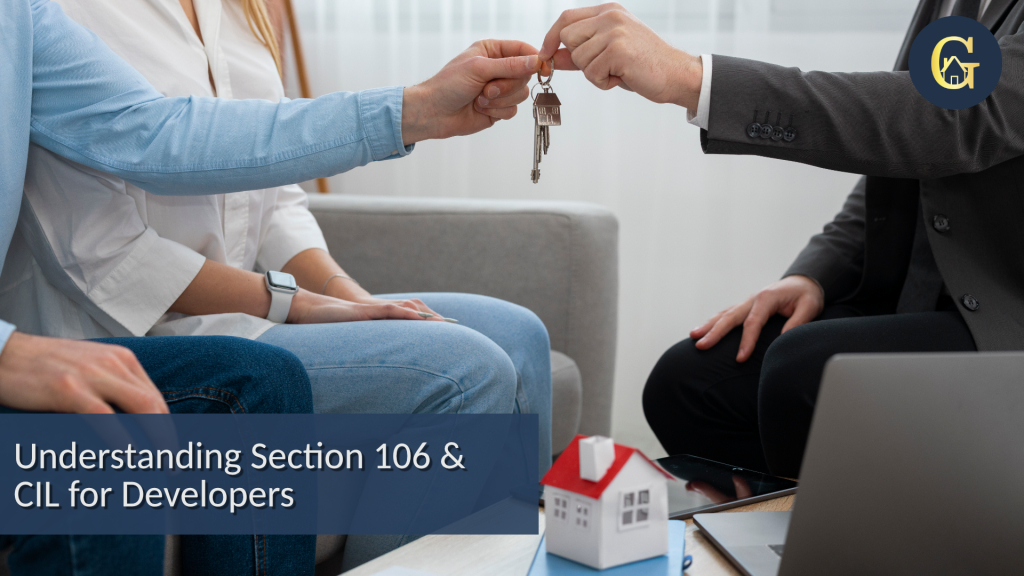You’ve found a promising site, the numbers look solid, and planning seems achievable. But before you move forward, there’s a hidden cost that could crush your margins: developer contributions.
Two major culprits? Section 106 agreements and the Community Infrastructure Levy (CIL).
These planning obligations can quietly add tens or even hundreds of thousands to your bottom line — and if you don’t factor them in early, you may find your “profitable” deal quickly becomes a liability. At GoldHouse Accounting, we help developers see the full financial picture before committing. Here’s what you need to know.
What Are Section 106 and CIL Charges?
Both Section 106 and CIL are planning obligations but they serve different purposes:
Section 106 Agreements (S106):
A negotiated, site-specific legal agreement. Commonly used for affordable housing contributions, public open space, highways, or local services.
Community Infrastructure Levy (CIL):
A fixed, non-negotiable charge per square metre of new development, introduced to help fund local infrastructure.
In short: CIL is automatic, while S106 is negotiated but both can affect your cashflow, profit, and viability if overlooked.
When These Charges Apply (And When They Don’t)
These charges usually apply to new residential or commercial developments, but not always.
You may be liable if:
- You’re creating new dwellings
- You’re converting larger commercial or agricultural buildings
- You’re adding new floor space (above 100 sqm for CIL)
You may be exempt if:
- The development is self-build or charitable
- You’re converting an existing residential building (with continuous use)
- You’ve secured a CIL exemption or relief before starting works
Always check the local authority’s CIL charging schedule and S106 policies — they vary dramatically between regions.
Calculating CIL & Section 106 Costs for New Builds
CIL is usually calculated like this:
CIL = Rate per sqm × Net additional gross internal floor space
Rates can vary from £0 to £500+ per sqm, depending on location and development type. Some London boroughs and high-growth areas apply hefty charges.
S106 is harder to quantify, as it’s often bespoke but developers commonly face:
- £20k–£100k+ affordable housing contributions
- Site-specific highway or amenity upgrades
- Management company arrangements or maintenance fees
We help developers model these into early-stage appraisals so you’re never caught off guard.
How These Impact Your Profit Margins and Appraisals
Ignoring CIL and S106 at acquisition stage is one of the most common mistakes we see.
These costs directly reduce your profit on cost and can significantly affect:
- Feasibility of your finance package
- Return on Investment (ROI)
- Net profit extraction
- Investor returns or sale price viability
In some cases, failing to account for these charges has wiped out 20–30% of projected profit.
Tips for Negotiating or Reducing Charges
While CIL is usually fixed, Section 106 is negotiable and timing matters.
Tactics we recommend:
- Use a viability assessment to argue for reduced obligations
- Re-phase large developments to delay contributions
- Identify areas for affordable housing relief
- Work with experienced consultants to challenge inaccurate CIL assumptions
At GoldHouse, we work alongside planning consultants to ensure your tax and cashflow strategy complements your planning approach.
Final Thoughts: Know Before You Build
Success in property development isn’t just about vision, it’s about precision. Understanding and planning for Section 106 and CIL charges means you can:
- Protect your margins
- Reduce your tax stress
- Scale with confidence
- Build a legacy that lasts
At GoldHouse Accounting, we help developers structure smarter deals, plan their exits, and turn complexity into clarity from the UK to Dubai and beyond.
Got a site in mind? Book a call with GoldHouse today to assess the real numbers and build your next deal with full confidence.



